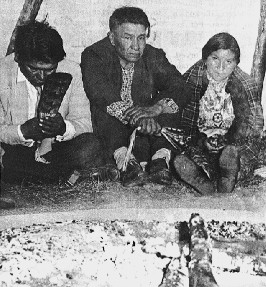
Visionary Cactus Guide

THE NATIVE AMERICAN CHURCH
Peyote is considered to be divine by the Indians, a messenger that allows the faithful to communicate with God without the need of a priest.
![]()
History from 1870's to present.
Peyote use was more or less unknown North of the Rio Grande until around the Civil War. During the war, some white soldiers, and even some federal marshals had a chance to try this new "green whiskey". By the wars end, and into the 1870's, increased contact between American and Mexican Indians helped to spread the Peyote cult Northward.
It was during this time period that the last of the free plains Indians were being herded on to reservations. Their population was decimated by starvation and disease, the great herds that they depended on for their very survival were just a sad memory. The few Indians that had survived to this point were hungry and impoverished, with absolutely no hope, no future. They were totally at the mercy of the white Christian oppressors, they were as unwanted slaves in their own lands.
This was the time of the Ghost Dance, the only futile hope for a future that the Indian had known in many years. The ghost dance was a form of worship that spread like wild fire in the 1880's. Basically it was a belief that if one was pure, obeyed certain rituals, and prayed hard enough, that the souls of all of the ancestors would be reborn and would destroy the white enslaver. It was also thought that the dance would bring back the game and the buffalo, so the Indians would no longer go hungry. This obviously did not sit well with the paranoid whites, particularly those close to the reservations. This was the time of the horrible massacre at Wounded Knee.
During this same time period Peyote was also making inroads into North American Indian culture. The Apache and Tonkawas were two of the first tribes to embrace Peyote. Around the turn of the century, the Comanche and Kiowa also engaged in the ritual. Soon afterwards over 50 different tribes began using the sacrament of Peyotyl.
Three men were the most influential in the spread of the Peyote religion:
The first was John Wilson, a Caddo-Delaware-French man who was renowned as a Ghost Dance leader. Legend has it that Wilson and his wife went into the forest, where he ate 15 buttons a day for 2 weeks. It was during these experiences that he was instructed on such things as how to paint his face and how to sing the holy songs, by the Peyote. He was shown the path to enlightenment, and was told to walk this path for the rest of his life, and remain faithful to Peyotes teachings.
The second influential figure was the famous Quanah Parker, a half white, Comanche chief. Laying in his tepee, dying, after all attempts to cure him by doctors and medicine men failed, he was visited by a Tarahumara curandera. Within a few days after ingesting Peyote tea, he was returned to health. The experience so changed him, that he gave up violence, and dedicated the rest of his life to spreading the teachings of Peyotyl.
Finally, the third major player was James Mooney, a Smithsonian Institute archeologist. He traveled through 1891 Oklahoma to participate in Peyote ceremonies. Mooney became convinced of the need to unite the Indians, and protect their legal right to worship with Peyote. He called together a meeting of all of the great "roadmen" in 1918, and wrote the charter for and incorporated the Native American Church.
The practices of the Native Americans differed from that of the shamanistic rituals used by their Mexican counterparts. The American tribes blended in Christian theology, and emphasized a communal ceremony of chanting, meditation and prayer.
By the year 1922, the Native American church claimed 22,000 members. That number exceeds 250,000 today.
From the turn of the century, the self righteous white oppressors attempted to have the use of Peyote outlawed. The first recorded case of the religious persecution of the Indians occurred in Oklahoma. In 1907, three Kickapoo Indians were arrested and fined $25 each, plus court costs for using the sacred Cactus. There were numerous other attempts on the State and Federal levels to outlaw Peyote. Laws banning Peyote were enacted in 11 Southwestern States.
The apparent "death blow" against Peyote oppression occurred in 1960, when an enlightened Arizona Judge Yale McFate, ruled that the Native Americans were guaranteed access to the Peyote sacrament under First and Fourteenth amendment rights.
In more recent times, the rights of Native Americans to engage in the Holy Sacrament have continually been reaffirmed.
Some other organisations dedicated to the Peyote way are:
The Peyote Way Church of God. Their address is Star RT - 1, Box -7X, Willcox AZ 85643. By becoming a member of the Church, you will be protected from prosecution in the States that allow the Peyote sacrament.
![]()

